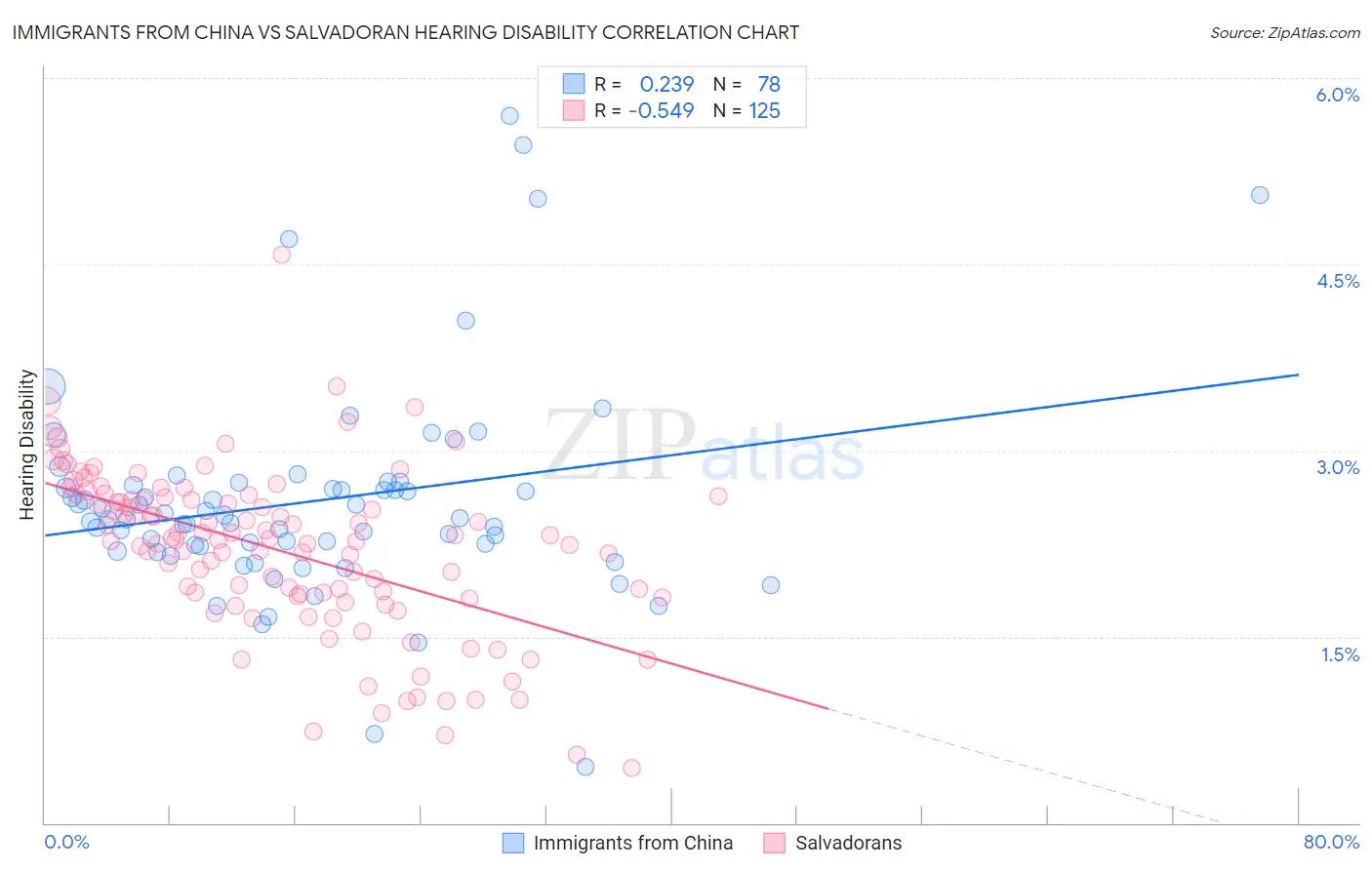Immigrants from China vs Salvadoran Hearing Disability
COMPARE
Immigrants from China
Salvadoran
Hearing Disability
Hearing Disability Comparison
Immigrants from China
Salvadorans
2.6%
HEARING DISABILITY
99.5/ 100
METRIC RATING
39th/ 347
METRIC RANK
2.6%
HEARING DISABILITY
99.6/ 100
METRIC RATING
35th/ 347
METRIC RANK
Immigrants from China vs Salvadoran Hearing Disability Correlation Chart
The statistical analysis conducted on geographies consisting of 456,804,939 people shows a weak positive correlation between the proportion of Immigrants from China and percentage of population with hearing disability in the United States with a correlation coefficient (R) of 0.239 and weighted average of 2.6%. Similarly, the statistical analysis conducted on geographies consisting of 398,804,647 people shows a substantial negative correlation between the proportion of Salvadorans and percentage of population with hearing disability in the United States with a correlation coefficient (R) of -0.549 and weighted average of 2.6%, a difference of 0.57%.

Hearing Disability Correlation Summary
| Measurement | Immigrants from China | Salvadoran |
| Minimum | 0.45% | 0.44% |
| Maximum | 5.7% | 4.6% |
| Range | 5.2% | 4.1% |
| Mean | 2.6% | 2.2% |
| Median | 2.5% | 2.3% |
| Interquartile 25% (IQ1) | 2.2% | 1.8% |
| Interquartile 75% (IQ3) | 2.7% | 2.6% |
| Interquartile Range (IQR) | 0.49% | 0.81% |
| Standard Deviation (Sample) | 0.87% | 0.67% |
| Standard Deviation (Population) | 0.86% | 0.67% |
Demographics Similar to Immigrants from China and Salvadorans by Hearing Disability
In terms of hearing disability, the demographic groups most similar to Immigrants from China are Haitian (2.6%, a difference of 0.080%), Immigrants from Jamaica (2.6%, a difference of 0.24%), Immigrants from Western Africa (2.6%, a difference of 0.32%), Okinawan (2.6%, a difference of 0.35%), and Immigrants from Taiwan (2.6%, a difference of 0.42%). Similarly, the demographic groups most similar to Salvadorans are Immigrants from Pakistan (2.6%, a difference of 0.12%), Filipino (2.6%, a difference of 0.16%), Okinawan (2.6%, a difference of 0.22%), Immigrants from Western Africa (2.6%, a difference of 0.25%), and Immigrants from Jamaica (2.6%, a difference of 0.33%).
| Demographics | Rating | Rank | Hearing Disability |
| Immigrants | South Central Asia | 99.7 /100 | #27 | Exceptional 2.6% |
| Immigrants | Haiti | 99.7 /100 | #28 | Exceptional 2.6% |
| Bolivians | 99.7 /100 | #29 | Exceptional 2.6% |
| Immigrants | Caribbean | 99.7 /100 | #30 | Exceptional 2.6% |
| Immigrants | Cameroon | 99.7 /100 | #31 | Exceptional 2.6% |
| Immigrants | Venezuela | 99.7 /100 | #32 | Exceptional 2.6% |
| Filipinos | 99.6 /100 | #33 | Exceptional 2.6% |
| Immigrants | Pakistan | 99.6 /100 | #34 | Exceptional 2.6% |
| Salvadorans | 99.6 /100 | #35 | Exceptional 2.6% |
| Okinawans | 99.6 /100 | #36 | Exceptional 2.6% |
| Immigrants | Western Africa | 99.6 /100 | #37 | Exceptional 2.6% |
| Immigrants | Jamaica | 99.5 /100 | #38 | Exceptional 2.6% |
| Immigrants | China | 99.5 /100 | #39 | Exceptional 2.6% |
| Haitians | 99.5 /100 | #40 | Exceptional 2.6% |
| Immigrants | Taiwan | 99.4 /100 | #41 | Exceptional 2.6% |
| West Indians | 99.4 /100 | #42 | Exceptional 2.6% |
| Senegalese | 99.4 /100 | #43 | Exceptional 2.6% |
| Nigerians | 99.4 /100 | #44 | Exceptional 2.6% |
| Venezuelans | 99.4 /100 | #45 | Exceptional 2.6% |
| Immigrants | Dominica | 99.3 /100 | #46 | Exceptional 2.6% |
| Immigrants | Israel | 99.3 /100 | #47 | Exceptional 2.6% |